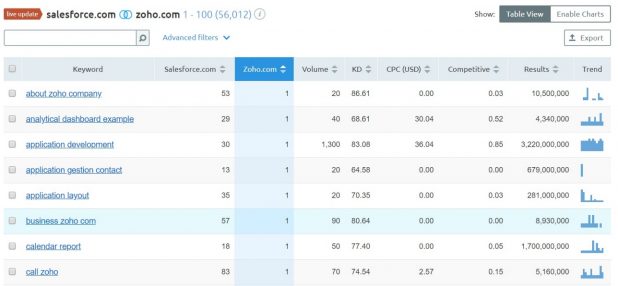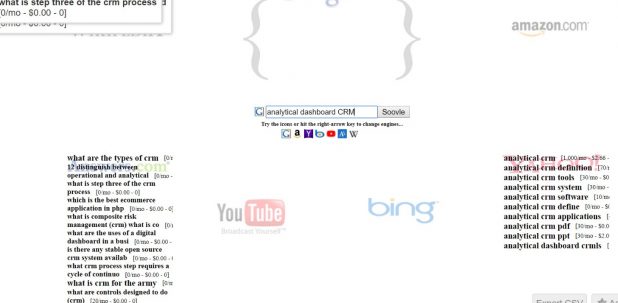For me, one of the hardest parts of SEO content writing is finding the right keywords to optimize for. I have an amazing team of content writers and SEO copywriters who can easily write content that ranks.
But what should it rank for?
That’s the million dollar question.
You see, we make dozens of keyword analyses at Idunn, both for our in-house content and for our clients’ SEO content. It’s not hard to find keywords in general. Google Ads Planner can help you find keywords with low to medium difficulty and a decent search volume.
The hard part is mapping those keywords to ROI. Read: if I rank for this keyword, will I make any money off it?
I’ve given this example a lot: I wouldn’t even try ranking my agency’s website for keywords like ‘SEO content’. It’s way too competitive and, more importantly, it’s not profitable.
I don’t want to attract people who are looking for definitions. I want to attract people who are ready to buy our services. So, I optimize for ‘SEO content writers for hire’ instead.
But what do you do when you run out of ideas for profitable keywords?
Here’s my answer: dig into the competitors’ keywords. Enter keyword gap analysis.
What is keyword gap analysis?
Keyword gap analysis is the process of finding keywords that bring traffic to your competitors’ website, but not to yours. It’s a great way to find opportunities that simply didn’t cross your mind before.
The best part about this process is that it’s mostly automated.
Keyword gap analysis tools
There are a lot of tools that offer this service.
The Hoth offers a free version (in exchange for your email address). Alexa offers a free trial.
But perhaps the most popular options are the paid ones from Ahrefs and SEMrush.
Once you’ve settled on a tool, you’re ready to start the process.
How to perform keyword gap analysis
Note: I will demonstrate this process using SEMrush. If that’s not your favorite tool, don’t sweat it. The process is fairly simple and almost identical no matter what you use.
Step 1: Identify competitors
I assume that you already know who your main competitors are. If not, do a quick Google search using the exact name of your products or services. Narrow it down to your geographical area (if needed) and you’re set to go.
Step 2: Keyword generation
Write the domain names of your competitors in your tool of choice. You can usually compare more competitors, but I’ll keep this one simple:
I chose to compare Salesforce to Zoho. They are two of the main CRM systems providers. Below each domain, you can see the ‘Organic Keywords’ option. You can also analyze paid keywords and PLA keywords, but that’s another story for another day.
Let’s see what the analysis reveals:
After the report is compiled, you will have some data to sift through.
The column headers tell you the search volume (Volume), the difficulty to rank organically for each keyword (KD), the cost-per-click you’d have to pay to rank in ads for the same keyword (CPC), the competitive density of advertisers trying to rank for it (Competitive), the number of results Google currently displays for a query (Results) and how the interest in a keyword has shifted over the past 12 months (Trend).
Step 3: Finding the sweet spot
Most of the keywords you’ll get will be useless business-wise. Some of them are generic terms, others are spelling errors.
Don’t be tempted to go for the generic terms like ‘application development’, especially if they are not what you are actually selling. Their high difficulty level doesn’t justify the investment.
The second keyword, on the other hand, may amount to something. ‘Analytical dashboard example’ can be easily refined into a blog post targeting people who look for insightful CRM reporting.
Step 4: Further analysis
I would turn the above keyword into ‘analytical dashboard CRM’. This way, I could target people who are looking into investing in a CRM and know exactly what they want out of it.
Now let’s see some more suggestions around this term. One of my most recent discoveries is Soovle, a tool that scrapes suggested keywords from multiple sources (Google, Bing, Amazon and more).
The best part about it is that everything happens in a single place. These are the results for my query:
As you can see, not all sources have suggested keywords. But that’s OK – my query is a bit of a hipster query. If I were to search for a really popular term like ‘running shoes’, the screen would fill immediately.
And the best part is that you can simply drag and drop the suggestions you like into the ‘saved’ category. This way, you’ll have a pretty neat collection of keywords that can help you beat Zoho’s ranking.
Step 5: Start writing
But before, make sure you can write a better article or page than your competitor did. That’s the only way to beat them. Take a look at the length of their content, the number of visuals they used and their outbound linking strategies.
If you want a shortcut, SEMrush and Ahrefs both offer a sort of ‘template’ service which tells you exactly how much you need to write to beat competitors in SERPs.
Here’s one thing that no tool can do for you: write compelling content. Make sure that you don’t simply follow bots’ instructions and that you bring value to the table.
Your content should be more comprehensive, better written and better optimized than your competitors’. Bear in mind that yours will be brand-new, while theirs has probably amassed some backlinks by now. So you need to prove your worth.
If you need help with content that ranks well, reads well and converts like a cash machine, drop us a line. Our specialty at Idunn is writing content that brings in meaningful traffic that helps your business grow.








